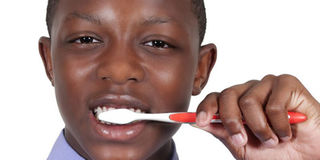How stuff works: Brushing teeth

A boy brushing his teeth. Photo/FILE
What you need to know:
- Regular flossing (at least every other day) is highly recommended to eliminate plaque from in between the teeth.
How should I brush my teeth?
Proper brushing should last at least three to five minutes and should, essentially, be after meals. Brushing twice daily should suffice: in the morning after breakfast, and at night before retiring to bed.
Be systematic in your brushing pattern and use short but gentle strokes. Pay extra attention to back teeth, which are not easy to reach, the gum line and teeth with crowns and fillings as these are vulnerable to cavities.
Regular flossing (at least every other day) is highly recommended to eliminate plaque from in between the teeth.
Start by cleaning the outer surfaces of the upper teeth followed by the lower teeth. Tilt the toothbrush at an angle of 45 degrees next to the gum line and rotate it in circular motions away from the gum line.
Clean the inner surfaces of the upper teeth, followed by the lower teeth.
Clean the chewing surface of each tooth by applying short, back-and–forth strokes.
Finally, the tongue is the most forgotten part of the mouth when brushing. To achieve fresher breath, brush it gently to get rid of bacteria.
How important is the toothpaste I use?
It is advisable to use the kind of toothpaste that is right for you, and one that has been recommended by dentists.
There is a wide range of toothpaste in the market designed for various dental conditions such as sensitive teeth, cavities and stained teeth. Consult your dentist on the right toothpaste for you.
What type of toothbrush should I use?
A medium-bristle toothbrush is best for removing food particles as well as plaque from your teeth without hurting the gums or contributing to tooth wear.
In addition, small-headed toothbrushes are best as they can reach all parts of the mouth, and especially the hard-to-reach back teeth.
How often should I replace my toothbrush?
It is recommended that you replace your toothbrush after every three months or as soon as it begins to show any sign of wear, whichever comes first.
Also, consider replacing your brush after a bout of infection such as a cold or tonsillitis because the bristles can harbour germs, which can easily lead to re-infection.




